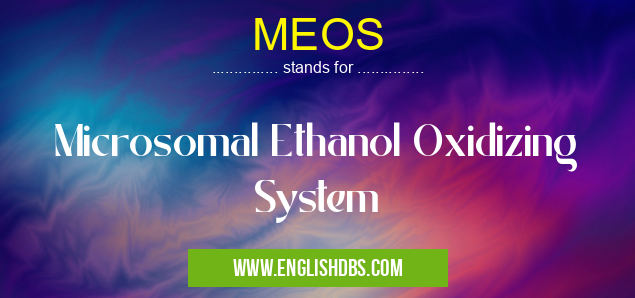What does MEOS mean in UNCLASSIFIED
Microsomal Ethanol Oxidizing System (MEOS) is a multi-enzyme system primarily responsible for oxidizing and breaking down ethanol in the liver. It is responsible for approximately 20% of ethanol metabolism in the human body.

MEOS meaning in Unclassified in Miscellaneous
MEOS mostly used in an acronym Unclassified in Category Miscellaneous that means Microsomal Ethanol Oxidizing System
Shorthand: MEOS,
Full Form: Microsomal Ethanol Oxidizing System
For more information of "Microsomal Ethanol Oxidizing System", see the section below.
MEOS Components
MEOS consists of several enzymes, including:
- Cytochrome P450 2E1 (CYP2E1): The primary enzyme involved in the oxidation of ethanol
- Alcohol dehydrogenase (ADH): A secondary enzyme that contributes to the oxidation of ethanol
- Catalase: An enzyme that breaks down hydrogen peroxide produced during alcohol metabolism
Ethanol Metabolism
MEOS plays a significant role in the detoxification of ingested ethanol:
- Phase 1: Ethanol is oxidized by CYP2E1 to acetaldehyde, a toxic metabolite.
- Phase 2: Acetaldehyde is further oxidized by ADH to acetate, a less toxic substance that can be excreted from the body.
Regulation of MEOS
The activity of MEOS is regulated by various factors:
- Ethanol intake: Chronic alcohol consumption can induce the expression of CYP2E1, resulting in increased MEOS activity.
- Genetic variations: Genetic polymorphisms in CYP2E1 can affect its activity and the rate of ethanol metabolism.
- Organ damage: Conditions such as liver disease can reduce MEOS activity, impairing ethanol elimination.
Clinical Significance
MEOS contributes to:
- Ethanol metabolism, reducing the accumulation of toxic metabolites
- Clearance of other xenobiotics (foreign compounds)
- Protection against alcohol-induced liver damage
Conclusion
The Microsomal Ethanol Oxidizing System (MEOS) is an essential component of the body's ethanol metabolism. Understanding MEOS can help in the development of therapies for alcohol-related disorders and the assessment of individual susceptibility to the adverse effects of alcohol.
Essential Questions and Answers on Microsomal Ethanol Oxidizing System in "MISCELLANEOUS»UNFILED"
What is MEOS?
MEOS (Microsomal Ethanol Oxidizing System) is an enzyme system located in the endoplasmic reticulum of liver cells that plays a role in the metabolism of ethanol (alcohol). It is responsible for oxidizing a small portion of ethanol, producing acetaldehyde, which is further metabolized by aldehyde dehydrogenase to form acetate.
What is the role of MEOS in alcohol metabolism?
MEOS contributes to the metabolism of approximately 10-20% of ingested ethanol. It has a relatively low capacity and affinity for ethanol compared to alcohol dehydrogenase, the primary enzyme responsible for ethanol metabolism.
How does MEOS function?
MEOS is a complex enzyme system involving cytochrome P450 enzymes (specifically CYP2E1), NADPH-cytochrome P450 reductase, and other cofactors. Ethanol binds to CYP2E1, which facilitates its oxidation and the production of acetaldehyde and hydrogen peroxide.
What factors influence MEOS activity?
MEOS activity can be affected by various factors, including genetic variations in CYP2E1, chronic alcohol consumption, and exposure to certain drugs and toxins. Chronic alcohol intake can induce CYP2E1 expression, leading to increased MEOS activity.
What is the clinical significance of MEOS?
MEOS is relevant to alcohol metabolism and its potential role in alcohol-related liver disease. Understanding MEOS activity can help in assessing alcohol consumption patterns and the risk of developing alcohol-induced liver damage.
